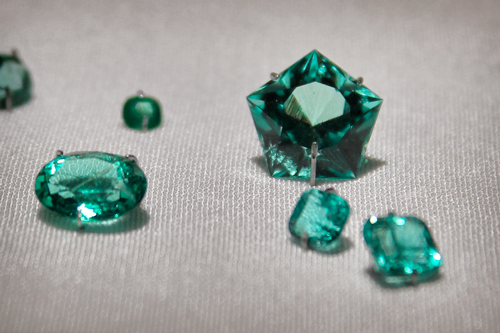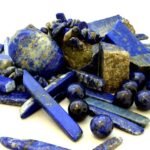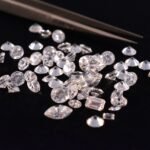Introduction: What Is an Emerald? Definition, Origins & Value
The emerald gemstone is one of the most cherished members of the beryl family, famous for its rich green color and historical importance. Known as the stone of love, growth, and prosperity, emeralds have been treasured since ancient civilizations like Egypt and India. Today, emeralds are used in both fine jewelry and spiritual practices, valued for their beauty and symbolism. Their worth depends on factors such as color, clarity, cut, and carat weight, making them one of the most desirable and sometimes expensive gemstones worldwide.
Color: What Makes the Best Emerald Color & How It Affects Price
The most valuable emeralds showcase a vivid green to bluish green tone, evenly distributed without being too dark or too light. Experts agree that Colombian emeralds often display the finest color saturation, while Zambian emeralds carry a slightly cooler, bluish green hue. The best emerald color has both intensity and brightness, dramatically increasing its price per carat. Stones that appear dull or too dark are less sought after, while medium-toned emeralds with strong brilliance command premium prices.
Clarity & Inclusions: Jardin Effect & What To Look For
Unlike Natural diamonds, emeralds almost always contain natural inclusions, known as the “jardin” effect (French for garden). These inclusions give each stone a unique character but can impact transparency. High quality emeralds are eye clean, meaning inclusions are not visible without magnification. However, inclusions are widely accepted in emeralds, as they confirm natural origin. Buyers should look for stones with good clarity without cloudy patches, since too many inclusions can weaken durability and reduce value.
Cut, Carat & Shape: Emerald Cut vs Other Shapes
The emerald cut is the most popular style, designed to highlight the stone’s color and minimize stress on internal inclusions. Other shapes include oval, pear, round, and cushion cuts, though these are less common due to higher cutting waste. Carat weight significantly influences price, as larger emeralds are rare. A high quality 2 carat emerald with vivid color and clarity may be more valuable than a 5-carat stone of lower grade, proving that quality outweighs size in gemstone pricing.
Popular Types of Emerald
Colombian Emeralds
Colombian emeralds are considered the finest emeralds in the world, known for their vivid green color and exceptional transparency. Muzo, Chivor, and Coscuez mines in Colombia produce stones with rich saturation and minimal undertones, making them highly prized among collectors and jewelers. These emeralds often display pure green or slightly bluish green tones, free from gray or brown shades that reduce value. Due to their rarity and beauty, Colombian emeralds command premium prices in the gemstone market.
Zambian Emeralds
Zambian emeralds are admired for their bluish green tone, high brilliance, and durability. Found mainly in the Kagem mines, these emeralds often contain fewer inclusions compared to Colombian stones, giving them better clarity and strength. Zambian emeralds typically appear darker in tone with a cooler green shade, which appeals to many modern jewelry lovers. They are also more affordable than Colombian emeralds, making them a popular choice for engagement rings, necklaces, and investment gems.
Brazilian Emeralds
Brazilian emeralds offer a lighter green color with subtle yellowish undertones, making them distinct from Colombian and Zambian varieties. Brazil’s Belmont and Itabira mines produce large crystals, often with good clarity, suitable for faceted stones and cabochons. Although their color may be less intense, Brazilian emeralds are highly valued for their size, brilliance, and availability. Collectors often seek them as affordable alternatives while still enjoying the beauty of natural emerald gemstones.
Pakistani Emeralds (Swat Valley Emeralds)
Pakistani emeralds, especially from the Swat Valley, are celebrated for their brilliant green color and exceptional clarity. These emeralds rival Colombian stones in beauty, with their vibrant hue and crystal-clear transparency making them highly desirable for fine jewelry. Due to their unique origin, Swat emeralds are rare in the market and cherished by collectors worldwide. Their limited supply, combined with stunning quality, makes Pakistani emeralds one of the most sought-after gemstone varieties.
Synthetic Emeralds (Lab-Created Emeralds)
Synthetic emeralds, also known as lab created emeralds, are synthetic gems with the same chemical composition and physical properties as natural emeralds. They display rich green hues and fewer inclusions, often appearing flawless to the naked eye. While they are more affordable than natural stones, synthetic emeralds offer beauty and durability at a fraction of the price. Many buyers choose lab emeralds for jewelry like rings and pendants, where sparkle and appearance matter more than rarity.
Trapiche Emeralds
Trapiche emeralds are among the rarest and most unique emerald types, displaying a star-like pattern created by carbon impurities within the stone. Found mainly in Colombia, these gems feature a six rayed wheel pattern that divides the green crystal into segments. Each trapiche emerald is one of a kind, making it a prized collector’s gemstone. Their distinct beauty and rarity make them highly sought after by gemstone enthusiasts and high-end jewelers.
Natural vs Synthetic Emeralds: What to Know Before Buying
Today, both natural and synthetic emeralds are available in the market. Natural emeralds form deep within the earth over millions of years, while synthetic emeralds are grown in laboratories using hydrothermal or flux methods. While synthetics share chemical properties with natural stones, they are far less valuable. When purchasing, always request certification from trusted labs like GIA or IGI to confirm authenticity and ensure you are paying the right price.
Emerald Treatments, Enhancements & Certification
Most emeralds undergo oil treatments to fill fractures and improve clarity. This is widely accepted in the gemstone trade, but the type of oil and treatment level should always be disclosed. Untreated emeralds are extremely rare and command premium prices. Buyers should ensure their gemstone comes with certification, detailing origin, treatments, and authenticity. Certified emeralds guarantee long-term value and reduce the risk of purchasing imitations.
Price Guide: Emerald Price Per Carat & Value Determinants
The emerald price per carat varies greatly depending on quality factors.
- Commercial grade emeralds: $30 – $200 per carat
- Fine quality emeralds: $500 – $3,000 per carat
- Top grade Colombian emeralds: $10,000+ per carat
Factors like origin, intensity of color, clarity, and treatment level heavily influence value. A small, vivid, untreated emerald can be worth more than a larger stone with poor clarity.
Emerald Jewelry Usage: Rings, Settings & Care Tips
Emeralds are widely used in engagement rings, necklaces, earrings, and bracelets. The stone’s rich green makes it a favorite choice for unique jewelry. However, emeralds rank 7.5 to 8 on the Mohs hardness scale, meaning they are durable but not as tough as diamonds. When set in rings, emeralds should be placed in protective settings such as bezels or halos. Cleaning should be done with mild soap and lukewarm water, avoiding ultrasonic or steam cleaners that can damage treated stones.
Symbolism & Popularity: Meanings, Trends & Collector’s Interest
The emerald is the birthstone of May and symbolizes rebirth, wisdom, and prosperity. Spiritually, it is believed to open the heart chakra, encouraging love and harmony. Collectors admire emeralds not only for their beauty but also as a solid gemstone investment, since top quality stones are becoming increasingly rare. In fashion, emerald jewelry remains timeless, making appearances on red carpets and royal collections across the globe.
Emerald Gemstone Quality Factors
The overall emerald quality is determined by a combination of color, clarity, cut, and carat weight commonly known as the Four Cs of Emeralds. Color is the most important, with deep, evenly distributed green hues being the most valuable. Clarity plays a crucial role, as fewer inclusions result in a more transparent and visually appealing gemstone. The cut of an emerald affects its brilliance, with well cut stones showcasing optimal light reflection. Lastly, carat weight impacts value, with larger stones being rarer but only desirable if they maintain excellent color and clarity. By understanding these emerald quality factors, buyers can make informed decisions when purchasing high-quality emeralds for jewelry or investment.
Emerald Engagement Rings & Jewelry Trends
The trend of emerald engagement rings has been on the rise as more people seek unique and colorful alternatives to traditional diamonds. The emerald cut diamond engagement rings offer a timeless appeal, combining elegance with modern aesthetics. Many couples prefer emerald and diamond rings as they symbolize love, growth, and renewal. The demand for emerald cut engagement rings is increasing, especially among those who appreciate vintage and classic designs.
The History and Meaning of Emeralds
Emeralds Gemstones have been treasured for centuries, dating back to ancient civilizations such as the Egyptians, Romans, and Incas. Cleopatra was known for her love of Colombian emeralds, often adorning herself with these radiant green stones. The name “emerald” originates from the Greek word “smaragdos,” meaning “green gem.”
Symbolically, emeralds represent rebirth, fertility, and eternal love. Many believe that wearing an emerald ring enhances wisdom and prosperity. In astrology, panna stone (the Hindi name for emerald) is linked to Mercury and is thought to bring clarity and success.
Comparison of Popular Emerald Types
| Type of Emerald | Origin | Color & Tone | Clarity | Value & Rarity |
|---|---|---|---|---|
| Colombian Emeralds | Colombia (Muzo, Chivor, Coscuez) | Pure green to slightly bluish-green, vivid saturation | High transparency, minimal undertones | Considered the finest; very rare and expensive |
| Zambian Emeralds | Zambia (Kagem Mines) | Bluish-green, darker tone | Fewer inclusions, durable | Affordable compared to Colombian; popular in jewelry |
| Brazilian Emeralds | Brazil (Belmont, Itabira) | Light green, sometimes with yellow undertones | Good clarity, larger crystals | More affordable; valued for size and brilliance |
| Pakistani Emeralds | Pakistan (Swat Valley) | Brilliant green with exceptional clarity | Crystal-clear, minimal inclusions | Rare in the market; highly desirable by collectors |
| Synthetic Emeralds | Lab-created | Rich green, flawless appearance | Very high clarity, fewer inclusions | Affordable alternative; same properties as natural emeralds |
| Trapiche Emeralds | Colombia | Green with six-rayed star-like pattern | Unique internal structure | Extremely rare; prized by collectors for uniqueness |
Popular Types of Emerald Jewelry
Emeralds are widely used in various jewelry designs, from emerald engagement rings to sophisticated emerald pendant necklaces. Their deep green hues make them an excellent centerpiece for various accessories, including emerald bracelets, emerald stud earrings, and emerald necklaces. The versatility of emeralds allows them to be paired with diamonds, gold, and other precious stones to create stunning jewelry pieces.
Natural vs. Lab-Grown
Emeralds can be found in natural and lab created forms. Natural emeralds, particularly Colombian emeralds, are highly valued due to their rarity and deep color. Other major sources include Zambia, Brazil, and Afghanistan.
Lab grown emeralds, also known as lab created emeralds, possess the same physical and chemical properties as natural emeralds but are more affordable and free of natural inclusions. Lab grown emerald cut diamonds are also gaining popularity for those seeking an eco-friendly alternative.
Emerald Gemstone Investment and Market Trends
Emeralds are considered a valuable investment due to their rarity and increasing demand in the jewelry market. The value of emerald stones has steadily risen, making them a worthwhile addition to any gemstone collection. The popularity of emerald tennis bracelets, emerald necklaces, and emerald earrings has grown significantly, contributing to the stone’s high market value.
How to Buy the Best Emerald Online
Buying emerald gemstones online requires careful research to ensure authenticity and quality. When purchasing emerald rings for women, it is essential to check for certifications, seller credibility, and detailed gemstone descriptions. The demand for loose emerald stones for sale has led to the emergence of many online jewelers offering high quality stones. Always look for a trusted natural emerald company when purchasing emerald jewelry online.
FAQs about Emerald Gemstones
The best emerald color is a vivid green to bluish-green with high saturation and brightness.
Colombian emeralds are considered the rarest and most valuable due to their deep green color.
Yes, but they require proper care due to their inclusions and slightly softer nature.
Real emeralds usually contain inclusions (jardin effect). Certification from GIA, IGI, or similar labs ensures authenticity.
Emeralds are rare and have a unique color, making them more valuable than stones like peridot or green tourmaline.
Yes, but with care. Avoid knocks, harsh cleaning, or exposure to chemicals to maintain their beauty.
Yes, but they should be set in protective settings and handled with care.
Natural emeralds generally do not fade, but prolonged exposure to strong heat or sunlight can reduce brightness.
Use mild soapy water and a soft brush to clean your emerald jewelry, avoiding harsh chemicals.
Yes, untreated emeralds are rarer and more valuable, though oil treatments are widely accepted in the industry.
Yes, emeralds are believed to bring prosperity, love, and protection to the wearer.
The emerald cut diamond is one of the most popular choices, offering a sophisticated and elegant look.
Conclusion
Emerald gemstones are among the most captivating and valuable gems in the world. Their deep green color, rarity, and versatility make them a top choice for emerald jewelry, from emerald engagement rings to emerald cut diamond rings. Whether you want to invest in a natural emerald stone, purchase elegant emerald rings, or admire the beauty of this precious gemstone, understanding its properties and value ensures the best choice. When buying emerald rings online, always choose certified emeralds from trusted sellers to guarantee authenticity and quality.






